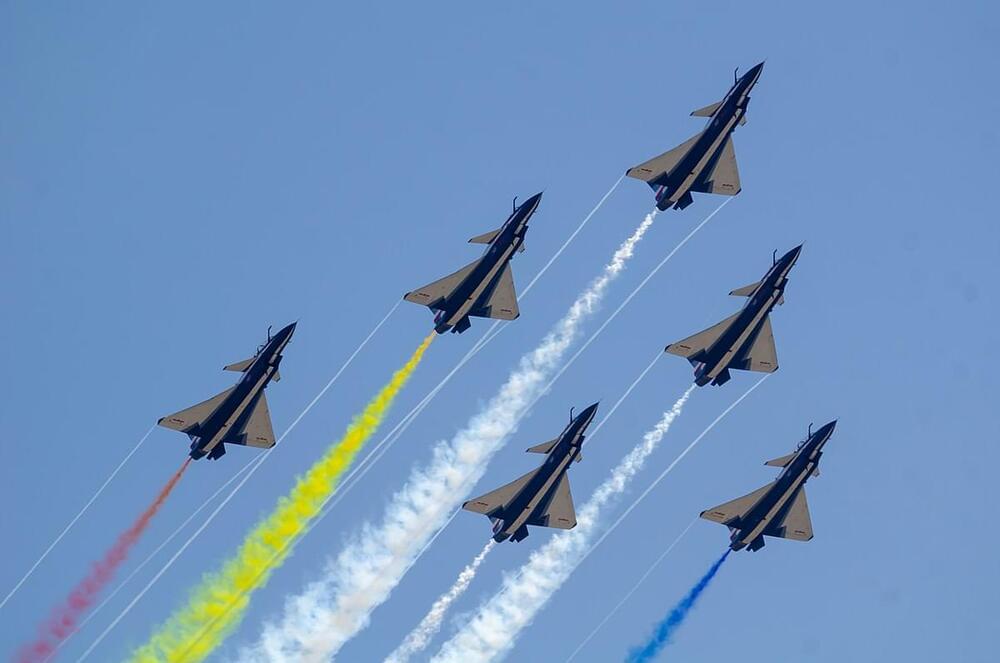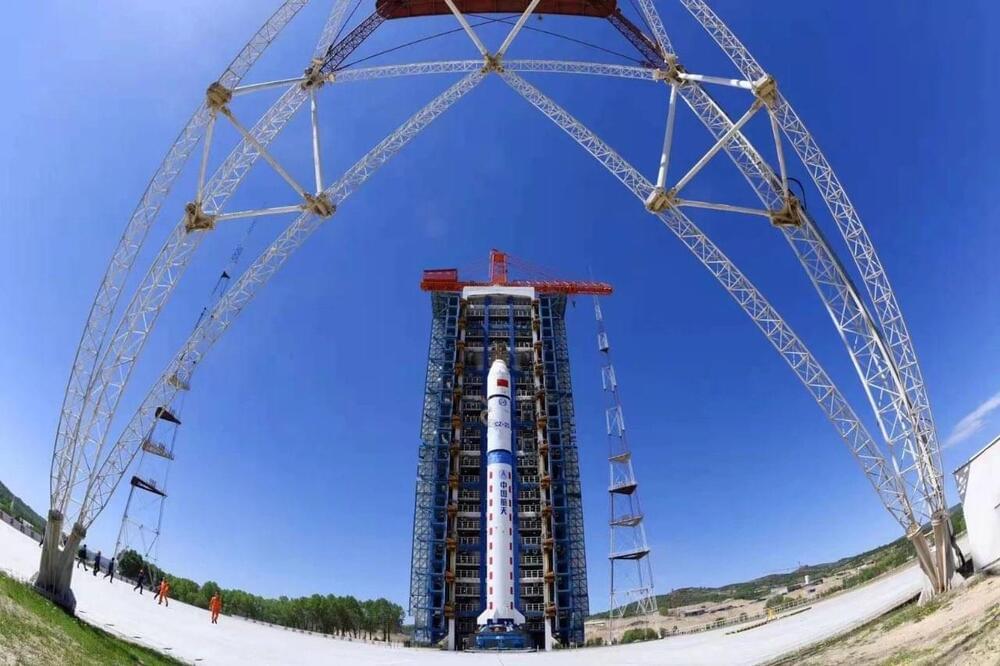The US Navy’s new Ford-class carriers use the Electromagnetic Aircraft Launch System to catapult planes off their decks, and France wants it too.



China’s growing military prowess dominated global headlines in 2021. Beijing’s fast-paced developments — be it the innovation in hypersonic technology, indigenous aircraft, or naval power — took the world by surprise and sent the alarm bells ringing in the West.
The EurAsian Times takes a look at five big developments in China’s weapons research and development.
Chinese Manned Space Agency (CMSA) is in the process of constructing a space station, called Tiangong, in the low Earth orbit (LEO). This construction gained a major milestone in May this year when Beijing launched Tianhe, the first module of the orbiting space station.
Lethal autonomous weapons systems (LAWS), also called “killer robots” or “slaughterbots” being developed by a clutch of countries, have been a topic of debate with the international military, ethics, and human rights circles raising concerns. Recent talks about a ban on these killer robots have brought them into the spotlight yet again.
What Are Killer Robots?
The exact definition of a killer robot is fluid. However, most agree that they may be broadly described as weapons systems that use artificial intelligence (AI) to identify, select, and kill human targets without any meaningful human control.
While rotating at up to 10 degrees per second!
The technological competition between the United States and China is growing at breakneck speeds.
A small and relatively low-cost satellite by China can allegedly take high-resolution images of cities in mere seconds, The South China Morning Post first reported. The images are allegedly so detailed that they can be used to identify specific military vehicles and weapons.
An impressive act proving this statement was performed by Beijing-3, a small commercial satellite launched by China in June. Beijing-3 conducted an in-depth scan of the San Francisco Bay, which corresponds to roughly 1,470 sq mi (3,800 sq km), within 42 seconds, according to scientists involved in the satellite project who published the results this month in the Chinese peer-reviewed journal Spacecraft Engineering.
Full Story:

The Chinese inroads into space have got strategic circles abuzz with discussions about a possible revival of a Cold War-type competition between the US and the erstwhile Soviet Union.
China has yet again made headlines with a move that goes beyond just sending missions to the Moon or Mars. It has claimed to have launched a satellite that could take high-resolution photos of American cities from space, which can capture even details of a vehicle’s number plate.
According to experts, a Chinese satellite captured photographs of a vast region around a US city in just 42 seconds, crisp enough to recognize a military vehicle on the street and tell what type of weapon it might be carrying.

2.7 billion people on this planet have “deskless jobs,” many of which require bending, lifting, moving, and carrying. German Bionic just released the fifth generation Cray X AI-enhanced power suit, or exoskeleton, to help those billions of people with almost 70 pounds of additional lifting capacity, reducing the risk of back injury and repetitive stress injuries. The Cray X is already in use at BMW, IKEA, and the French delivery service DPD, and will be launched internationally in January 2022.
The AI-powered suit boosts productivity, reduces error rates, decreases accidents, and results in a 25% reduction in the number of sick days workers take, German Bionic says.
The smart exoskeleton market has been estimated to be growing 41.3% a year to a nearly $2 billion industry by 2025, with applications in construction, shipping and receiving, healthcare, and the military. But it’s not just for the billions in the workforce.

Apparently, China has managed to launch three new ships in a day.
According to sources like the Alibaba Group-owned South China Morning Post, Chinese ship makers managed to launch three new warships on Christmas Eve 2021. Destined for Thailand, Pakistan, and their own fleets, these ships are some of the country’s most advanced vessels.
Almost a mockery of the Christmas hymn I Saw Three Ships\.
https://youtube.com/watch?v=FzvvIlMySmQ&feature=share
✅ Instagram: https://www.instagram.com/pro_robots.
You are on the PRO Robots channel and in this form we present you the high-tech news. Flying humanoids, aerotaxi from the mayonnaise manufacturer Sloboda, Neuralink chip testing on people, new smart augmented reality glasses, nimble robots, new robots and other most interesting news from the world of technology in one release!
0:00 In this video.
0:25 A prototype of an unmanned air cab from the Sloboda brand.
1:29 Neuralink hopes to get approval for its brain chips soon.
1:55 Paris cab operator G7 has suspended Tesla Model 3 rides.
2:20 Hyundai has announced a robot with a great vestibular system.
3:16 Sony also unveiled a variant of the robot car.
3:51 American startup Stoke Space.
4:31 FarmHand robot arm.
5:25 An electroplane with bird legs and a tilting cockpit.
6:17 A competition, to teach any robot the stupidest, most inefficient, or weirdest gait.
6:47 The iRonCub research platform.
7:39 Air Glass augmented reality glasses.
8:45 Huawei to introduce its smart glasses with interchangeable lenses and Smart Glass speakers built into the temples.
9:06 Ray-Ban Stories smart glasses.
9:35 Swiss startup Ascento Robotics.
10:20 U.S. military has developed special software to predict China’s response.
10:48 Car thieves started using Apple’s AirTag.
11:11 Cray X carbon fiber exoskeleton.
11:54 Returning samples from Mars.
12:28 China’s first manned mission to the moon.
13:08 The U.S. Federal Trade Commission has filed a case against Mark Zuckerberg’s company Meta.
14:02 Happy New Year.
#prorobots #robots #robot #future technologies #robotics.
More interesting and useful content:
✅ Elon Musk Innovation https://www.youtube.com/playlist?list=PLcyYMmVvkTuQ-8LO6CwGWbSCpWI2jJqCQ
✅Future Technologies Reviews https://www.youtube.com/playlist?list=PLcyYMmVvkTuTgL98RdT8-z-9a2CGeoBQF
✅ Technology news.
https://www.facebook.com/PRO.Robots.Info.
#prorobots #technology #roboticsnews.

This all-electric 4×4 off-road concept has a monster battery pack, a brutally angular and military look that borrows heavily from the Cybertruck, and pop-out solar panels for off-grid charging. Oh, and if you need extra range, you can snap two extra wheels and a battery onto the back of it with a self-balancing caboose that makes it a six-wheel-drive.
First things first: Thundertruck is the brainchild of a Los Angeles “creative consultancy,” conceived mainly as a way to keep the team busy during the first wave of COVID lockdowns. “Instead of baking bread or making puzzles,” says the Wolfgang L.A. team, “we decided to make a new state-of-the-art EV truck.”
So while Wolfgang says it “has the ability to support an entire product development program, from research and strategy to initial sketches and first prototypes, all the way to advertising launch campaigns and content creation,” it’s fair to say it’s unlikely we’ll be seeing the Thundertruck out bush-bashing or crushing hillclimbs any day soon.
Reddit user jokes: ‘Not so stealthy now, are ya?’